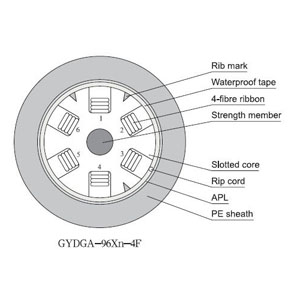-

- Sopto Home
-

- Special Topic
-

- Fiber Optics knowledge
-

- What is Inside of a Fiber Optic Cable
Fiber Optics knowledge
- Maintained Methods of Fusion Splicer Parts
- How to Use the Fiber Optic Cleaver?
- What are Fixed Attenuators & Variable Attenuators?
- Deployable Fiber Optic Systems for Harsh Mining Environments
- Developing Miniature Fiber Optic Cable Has Become the Trend
- Fiber Optic Cleaning Procedures
- 6 Steps to Selecting a Fiber Optic Cable
- Signal Attenuation Introduction
- How Fiber Transmission Works?
SOPTO Special Topic
Certificate



Guarantee
Except products belongs to Bargain Shop section, all products are warranted by SOPTO only to purchasers for resale or for use in business or original equipment manufacturer, against defects in workmanship or materials under normal use (consumables, normal tear and wear excluded) for one year after date of purchase from SOPTO, unless otherwise stated...
Return Policies
Defective products will be accepted for exchange, at our discretion, within 14 days from receipt. Buyer might be requested to return the defective products to SOPTO for verification or authorized service location, as SOPTO designated, shipping costs prepaid. .....
Applications
Fiber Optis can be used in so many fields:
Data Storage Equipment
Interconnects,Networking
Gigabit Ethernet
FTTx, HDTV,CATV
Aerospace & Avionics
Data Transfer Tests
Network Equipment
Broadcast Automotive
Electronics,Sensing
Oil & Gas, Imaging
Outside Plant,Central Office
Harsh Environment
Data Transmission
Illumination,Institutions
Ship to Shore,Education
Simulation,Military,Space
Unmanned Aerial Vehicles
Semiconductor Equipment
Diagnostics & Troubleshooting
Premise Networks Carrier Networks
Independent Telecommunication Providers
SOPTO Products
- Fiber Optic Transceiver Module
- High Speed Cable
- Fiber Optical Cable
- Fiber Optical Patch Cords
- Splitter CWDM DWDM
- PON Solution
- FTTH Box ODF Closure
- PCI-E Network Card
- Network Cables
- Fiber Optical Adapter
- Fiber Optical Attenuator
- Fiber Media Converter
- PDH Multiplexers
- Protocol Converter
- Digital Video Multiplexer
- Fiber Optical Tools
- Compatible
Performance Feature
Fiber Optics knowledge
Recommended


What is Inside of a Fiber Optic Cable?
Fiber optic cable is unlike most types of cables; it draws on light instead of electricity to transmit signals. As you have already known, the light is the fastest way to transfer information, and fiber optic cable has additional advantages are immune to electrical interference. So, you can run it anywhere and at any time.
Because light meets litter or no resistance, you can run the fiber optic cable in a long distance, literally countries apart, without increasing or clean signal. Imagination process is thousands of miles away. It will be impossible. Optical fiber velocity also has its own advantages. It has a cleaner signal than conventional copper wire and transmit signals over 10gb/s. Put it into perspective, fiber optic wiring is digital information as an electrical wiring is analog information. They are completely different.
At present, the fiber optic cable used to connect to the network, basically make the short run, the connection layer, construction and connection electric copper cable, fiber optic cable through the Ethernet converters.

Slotted-Core Fiber Optic Cable with Aluminum
Despite the fiber optic cable can be very expensive, but because it is becoming more and more popular, it will be, the price of fiber optic cable (and related equipment including Ethernet converter and fiber optic transceiver) should be reduced. Knowing what's inside this very functional invention is good to know.
A fiber optic cable includes the core, cladding, strength member, buffer and jacket as its components. Let's get to know them more! Core cable to the path of the transmitted light can flow, by one or more of the glass or plastic fiber. The cladding which provides a refractor light beam reflected back to the core, to continue its journey is usually made of plastic. The buffer consists of one or more layers of plastic and strengthens the cable and prevents damage to the core. As the same implies, the strength members are very hard materials, such as glass fiber, steel or kevlar, and provides additional strength for the cable.
Finally, the jacket which can either be plenum or non-plenum is the outer covering or shield of the cable. Fiber optic cable comes in two forms: single mode and multi-mode. Because single mode cable is so narrow, light can only travel through it in a single path. This cable is very expensive and is hard to work with. Multi-mode cable, on the other hand, there is a wide range of core diameter of the optical flow of the freedom to travel several paths.
Unfortunately, the multipath configuration multimode optical fiber allows the possibility of signal distortion at the receiving end. Sometime in your connection, you will come across connecting either a single mode or multi-mode fiber optic cable to conventional copper cable. This can be a problem which can cut the communication you have already established. But you don't have to worry as there are Ethernet converters and transceiver modules that serve to router, boost, and deliver the signals across these two opposite cables. On top of these, there are other related devices such as gigabit converters and SFP optical modules readily available on the market that you might find useful in your network.
For more information, please browse our website or contact a Sopto representative by calling 86-755-36946668, or by sending an email to info@sopto.com.





